Portuguese Fishery in the CECAF Area (1986–88)
Contribution to the Working Group on Hakes and Deep-sea Shrimp (Northern zone of CECAF) by Manuel Lima Dias - I.N.I.P., January 1990
INTRODUCTION
In 1987 and 1988 the Portuguese fleet operated in various areas of the CECAF region, as can be seen from the following table, with catches shown in metric tonnes.
| Madeira | 1987 | 1988 |
|---|---|---|
| 6.638 | 7.575 | |
| Morocco | 13.389 | 14.124 |
| Mauritania | 42 | 455 |
| Guinea-Bissau + Senegal + Sierra Leone | 15.63 | 3.226 |
| Total of African Coastal Countries | 14.994 | 17.805 |
| TOTAL | 21.632 | 25.380 |
The catches realized off the African coastal countries were more or less the same in both years with 69% and 70%, in 1987 and 1988, respectively of the total catches in the whole region. The Portuguese fishery in Division 34.1.2 (Madeira waters) was, as in previous years, mainly conducted concerned with tunas and tuna-like species as shown in the following table (captures by artisanal and tuna boat).
| Species | 1987 | 1988 | ||
|---|---|---|---|---|
| Tons. | % | Tons. | % | |
| Black scabbard fish - Aphanapus carbo | 2286 | 34 | 2724 | 36 |
| Tuna - Thunnusspp | 675 | 10 | 1728 | 23 |
| Horse mackerel - Trachurusspp | 1563 | 23 | 1764 | 23 |
| Chub mackerel - Scomber japonicus | 1593 | 24 | 903 | 13 |
| Total fishery | 6638 | 7575 | ||
With regard to CECAF Statistical Divisions 34.1.1, 34.1.3 and 34.3.1 information as to the origin of catches were not always reliable, specially off Mauritania and Morocco. In doubtful situations, catches and landings were refferred to more than one division, ex. 34.1.3 and 34.3.1.
The target species in the Northern Zone off the African coast have, in recent years, been not only the hake but also the seabreams, the scabbard fish (Lepidopus caudatus), the rubberlip grunt (Plectorhinchus mediterraneus), among others.
Many difficulties were encountered in obtaining reliable statistics of respective landings.
THE FISHERY
Taking into account only the fishery carried out off the African coastal countries, Table 1 shows the landings of the hakes (Merluccius spp), the seabreams (Sparidae) and the rubberlip grunt (Plectorhinchus mediterraneus) for 1949–1988. These historical statistical data of the most important species, or group of species, were previously elaborated for the CECAF Working Group and concerned only the seabreams. It is presently updated for 1985–1988 and the range of species enlarged.
Table 2, on the other hand, presents more species referring to the entire area of the CECAF and the main landings of the target fisheries report from 1979 to 1988 in Divisions 34.1.1, 34.1.3, 34.3.1 and 34.1.2. Some of the figures relating to recent years are also updated.
Table 3 presents statistics for Divisions 34.1.2 - Madeira,34.1.1-Morocco,34.1.3 + 34.3.1 Mauritania and 34.3.1 - Guinea - Bissau + Senegal +
THE HAKE FISHERY
Regarding the Portuguese hake fishery it is to be emphasized that it was impossible, with the present statistical data available, to separate data by fishing area and gear.
However, and considering that the highest percentage of catches concerns the European hake (Merluccius merluccius) fished mainly by artisanal gear (gill net and line) in the northern CECAF region, it is possible to estimate different volumes of catches, according to the two main groups of hakes and gears used.
The result of this estimation is presented on Table 4 which shows landings of each type of hake in the Morocco and Mauritania waters.
FISHING EFFORT
It is not possible to provide information on the fishing effort of the different Portuguese units operating in CECAF waters.
One of the main reasons is that exploitation was carried out by several units which at times operated in waters off the southern Portuguese coast and, fishing grounds further away (south-west of Sagres and in northern CECAF waters).
In 1988 47, 13, 5 and 18 fishing boats operated in Morocco, Mauritania, Senegal and Guinea-Bissau, respectively with the following average GRT:
| Morocco | 115 | tonnes |
| Mauritania | 161 | " |
| Senegal | 170 | " |
| Guinea-Bissau | 274 | " |
Attention is however drawn to the fact that some of these fishing boats were also operating not only in these areas but also off some other coastal countries, even though this was done sporadically.
Concerning the different fishing regimes of the Portuguese fleet fishing off the northern African countries, only about 3% of all boats operated in the Mauritania waters in 1988 while 97% operated mainly off Morocco. As for the fishery conducted in these waters, 71% fished under joint venture arrangement while only 29% fished under the EEC/Morocco agreement.
Considering the main gears used by the Portuguese fleet operating in this area, the reference to “polivalente” ships means that the gears used are artisanal, mainly gill nets and long-line. Some of the units also used traps.
In spite of all difficulties encountered, with reliable data it was possible to obtain some information which, together with other data directly obtained in the fishing harbours, permitted estimation of the percentage of ships using different gears. The result can be roughly summarized as follows:
| Off Morocco | 48% | units using gill nets and line |
| 22% | boats using line only | |
| 19% | trawlers | |
| 11% | purse seiners | |
| Off Mauritania | 77% | boats using gill nets and line |
| 17% | boats using line only | |
| 7% | trawlers |
For Mauritania, it should be emphasized that at least for the last three years some of the boats also fished with traps (for crustaceans). Lines and gill nets were used in the Senegalese area.
All these informations concern the entire Portuguese fleet, independently of the fishing regime.
BIOLOGICAL STUDIES
Taking into account the insufficient knowledge on the fishing grounds and on gears used, difficulties were encountered in recent years for a collection of reliable biological data. In spite of this, it was possible to develop a sampling programme in the main fishing harbours where the hakes, fished in the CECAF region were landed.
Tables 5, 6 and 7 show the length compositions of the hakes landed (mainly Merluccius merluccius) respectively for 1986, 1987 and 1988.
In 1987, it was also possible to obtain the length composition of the European hake, apart from the most important species present in the landings (Table 8). The mean length of the fishes was 55 cm and the mean weight 1.3 kg. On the other hand, the values of the mean length and mean weight for all the hakes landed during this year was respectively 43.8 cm and 1.4 kg.
Table 4 shows the 1988 estimates of the different landings of the white and the black hakes fished off Morocco and Mauritania, with different types of gears. Sampling were carried out along 1988 in fishing harbours for length composition of the hakes caught with gill net only (mainly white hake - M. merluccius and black hake - M. senegalensis) - Table 9. On the other hand, it was also possible to find out the length composition of the main species landed - Table 10 and Figure 2. (M. merluccius was mainly caught with trawl and gill net).This figure also shows the length composition of the black hake caught with gill net - Figure 2 B.
Note should be taken of the predominance of the catches of the European hake with gill net. From the total weight landed, 500.3 tonnes were from gill nets and only 26.8 tonnes trawl fishery (Table 10 and Figure 3.)
The last column of this table and figure 30 show the length composition of the European hake fished with both gears. The different length composition of fish landed with the two different gears is quite evident. The average length of hakes fished with trawl was 34.4 cm and that fished with gill net was 52.8 cm.
Figure 2 also shows the length frequency of the landings of the black hake fished with gill net.The same information concerns the whole hake fishery.
Taking into account all the 1988 biological data (length composition) on hakes - Merluccius spp. It can be observed that two main groups attained two main peaks at 28–29 cm and between 42–43 cm and 46–47 cm classes.The first group probably concerns the total number of small fish caught by trawlers and the second by liners and by boats with gill net (Figure 1).
Referring only to the European hake landed during 1988 and fished with gill net and trawl, with an estimated 527 tonnes (Table 10) fishery with gill net comprised about 95%. Such a situation could explain the total length frequency obtained for this species with both gears (last column of Table 10 and Figure 3).
It can be seen from Table 9 that values corresponded to length composition of M. merluccius landed and caught by gill net. The total of the European hake fished with this gear is about 63%. The mean length and mean weight of the European hake were as follows:
| European hake |  = 57.3 cm = 57.3 cm |  = 1.8 kg = 1.8 kg |
| Black hake |  = 48.7 cm = 48.7 cm |  = 1.3 kg = 1.3 kg |
Table 11 also shows the length composition of the whole sampling of M. merluccius senegalensis during 1988. Such a distribution is also presented on Figure 2 (2C).
| Years | Total Fishery | Hakes | Seabreams | Rubberlip grunt | Others | ||||
|---|---|---|---|---|---|---|---|---|---|
| Tons | Tons | %. | Tons | %. | Tons | %. | Tons | %. | |
| 1949 | 31524 | 8204 | 279.3 | 10514 | 333.5 | 3590 | 113.9 | 8616 | 273.3 |
| 50 | 31065 | 5933 | 191.0 | 11827 | 380.7 | 5059 | 162.9 | 8246 | 265.4 |
| 51 | 29665 | 7539 | 254.1 | 11192 | 377.3 | 4178 | 140.8 | 6756 | 227.7 |
| 52 | 32683 | 10697 | 327.3 | 10667 | 332.5 | 4654 | 142.2 | 6465 | 197.8 |
| 53 | 32857 | 11429 | 347.8 | 9622 | 292.8 | 3817 | 116.2 | 7989 | 243.1 |
| 54 | 34554 | 10104 | 292.4 | 9841 | 284.8 | 4088 | 118.3 | 10525 | 304.6 |
| 55 | 34200 | 10400 | 304.1 | 9172 | 268.2 | 4392 | 128.4 | 10236 | 299.3 |
| 56 | 37146 | 8055 | 216.8 | 11359 | 306.8 | 5144 | 138.5 | 12588 | 338.9 |
| 57 | 39979 | 8601 | 215.1 | 10475 | 272.0 | 5151 | 128.8 | 15352 | 384.0 |
| 58 | 40404 | 10242 | 253.0 | 10470 | 239.1 | 5059 | 125.2 | 14633 | 362.2 |
| 59 | 49550 | 7985 | 161.2 | 12251 | 247.2 | 7350 | 148.3 | 21964 | 443.3 |
| 1960 | 49591 | 8245 | 166.2 | 11059 | 233.0 | 6062 | 122.2 | 24227 | 488.5 |
| 61 | 49390 | 6591 | 133.4 | 10464 | 212.1 | 4279 | 86.6 | 28056 | 568.1 |
| 62 | 42500 | 4762 | 112.0 | 7978 | 187.7 | 3561 | 83.8 | 26199 | 616.4 |
| 63 | 42163 | 2718 | 64.5 | 6669 | 158.2 | 3300 | 78.3 | 29476 | 699.1 |
| 64 | 41320 | 4732 | 114.5 | 5302 | 133.2 | 2994 | 72.5 | 28092 | 679.8 |
| 65 | l. | 9585 | 239.1 | 5495 | 136.1 | 1969 | 49.1 | 2083 | 573.7 |
| 66 | 36712 | 104064 | 285.0 | 4623 | 125.7 | 1057 | 28.8 | 20578 | 560.5 |
| 67 | 33877 | 10283 | 302.6 | 4244 | 124.9 | 1421 | 41.8 | 19029 | 530.6 |
| 68 | 33045 | 11107 | 336.1 | 3373 | 102.1 | 1281 | 38.8 | 17284 | 523.0 |
| 69 | 31103 | 9928 | 319.2 | 3837 | 123.4 | 1095 | 35.2 | 16243 | 522.2 |
| 1970 | 25745 | 6717 | 260.7 | 3405 | 15.2 | 986 | 38.3 | 14657 | 568.9 |
| 71 | 22550 | 5075 | 225.1 | 30341 | 1343.5 | 1470 | 45.2 | 14971 | 575.2 |
| 72 | 24932 | 5496 | 220.4 | 3239 | 130.0 | 1830 | 73.4 | 14366 | 576.2 |
| 73 | 28277 | 7575 | 267.9 | 3932 | 139.0 | 2020 | 71.4 | 14751 | 521.7 |
| 74 | 23042 | 7295 | 316.6 | 5830 | 232.6 | 2935 | 122.4 | 6992 | 303.4 |
| 75 | 20977 | 3942 | 189.8 | 4291 | 204.6 | 3018 | 143.8 | 9686 | 4417 |
| 76 | 29085 | 4701 | 161.6 | 4244 | 145.9 | 2833 | 97.4 | 17305 | 595.0 |
| 77 | 12770 | 856 | 67.0 | 3670 | 287.4 | 2637 | 206.5 | 5607 | 439.1 |
| 78 | 8524 | 364 | 42.7 | 3066 | 359.7 | 1501 | 176.1 | 3593 | 421.5 |
| 79 | 14714 | 523 | 35.4 | 4190 | 283.4 | 3471 | 234.2 | 6600 | 446.4 |
| 1980 | 15664 | 1767 | 112.8 | 3380 | 215.8 | 1738 | 111.0 | 8779 | 565.5 |
| 81 | 22808 | 135 | 10.5 | 3473 | 271.2 | 1867 | 145.8 | 7333 | 572.5 |
| 82 | l. | 199 | 15.8 | 2232 | 178.6 | 1810 | 144.9 | 8254 | 660.6 |
| 83 | 18258 | 176 | 9.6 | 3347 | 183.3 | 2051 | 112.3 | 12684 | 694.7 |
| 84 | 21118 | 240 | 11.4 | 3456 | 163.7 | 2927 | 138.6 | 14495 | 686.4 |
| 85 | 79460 | 575 | 19.5 | 5060 | 171.8 | 1003 | 135.9 | 19822 | 672.8 |
| 86 | 27742 | 2342 | 84.4 | 4659 | 167.9 | 2744 | 98.9 | 17997 | 648.7 |
| 87 | 20058 | 1766 | 88.0 | 3083 | 153.7 | 2060 | 102.7 | 13149 | 655 |
| 88 | 25379 | 1351 | 53.2 | 459 | 18.0 | 223 | 88.0 | 23346 | 919.9 |
| SPECIES | 1979 | 1980 | 1981 | 1982 | 1983 | 1984 | 1985 | 1986 | 1987 | 1988 | |
|---|---|---|---|---|---|---|---|---|---|---|---|
| Hakes | Merluccius spo. | 523 | 1767 | 135 | 198 | 170 | 242 | 575 | 2342 | 1766 | 1351 |
| Rubberlip grunt | Plectorhinchus sediterraneus | 3471 | 1738 | 1867 | 1810 | 2051 | 2927 | 4003 | 2744 | 2060 | 223 |
| Seabreans | Sparidae | 4190 | 3380 | 3473 | 2232 | 3347 | 3456 | 5060 | 4569 | 3083 | 435 |
| Horse makerel | Trachurus spp. | 779 | 6696 | 506 | 1804 | 6041 | 7011 | 9933 | 7980 | 4720 | 1985 |
| Tuna nei | Thunidae | 1038 | 261 | 530 | 967 | 748 | 1149 | 1400 | 1921 | 707 | 1728 |
| Black scabbard fis | Aphanoous carbo | 1068 | 1170 | 1164 | 1590 | 1775 | 1806 | 1497 | 2117 | 2302 | 2724 |
| Chub sackerel | Scoaber japonicus | 1040 | 1323 | 1077 | 1275 | 1107 | 1216 | 1426 | 1104 | 1604 | 915 |
| Other fish mollusc and crustaceans | 2666 | 5329 | 4056 | 2618 | 3013 | 3311 | 5566 | 4965 | 5390 | 16019 | |
| TOTAL ( Tons ) | 14775 | 15664 | 12606 | 12494 | 18258 | 21118 | 29460 | 27742 | 21632 | 25380 |
| Areas of operation | CECAF STATIES DI | 1979 | 1980 | 1981 | 1982 | 1983 | 1984 | 1985 | 1986 | 1987 | 1988 |
|---|---|---|---|---|---|---|---|---|---|---|---|
| Madeira | 4698 | 4210 | 3919 | 4905 | 5063 | 5711 | 6874 | 7487 | 6638 | 7575 | |
| Morocco | 34.1.1 | 15103 | 13389 | 14124 | |||||||
| Maurit. | 34.1.373.1 | 5152 | 47 | 455 | |||||||
| Guinea-Bissau + Senegal+Sierra Leone 343.1 | 15631 | 3226 | |||||||||
| Not known | 10077 | 11454 | 8889 | 7589 | 13195 | 16499 | 22586 | ||||
| African coastal countries | 10077 | 11454 | 8889 | 7589 | 13195 | 16499 | 22586 | 20255 | 14994 | 17805 | |
| TOTAL | 14775 | 15664 | 12808 | 12494 | 18258 | 21118 | 29460 | 27742 | 21632 | 25380 | |
| Regions: MOROCCO | MAURITANIA | TOTAL | |||||||
|---|---|---|---|---|---|---|---|---|---|
| Hakes | White | Black | Total | White | Black | Total | White | Black | Total |
| Gears | |||||||||
| Trawl | 26 | 5 | 31 | 0.8 | - | 0.8 | 26.8 | 5 | 31.8 |
| Gill net | 499 | 287 | 786 | 1.3 | 4.2 | 5.5 | 500.3 | 291.2 | 791.5 |
| Trawl and Gill net | 525 | 292 | 817 | 2.1 | 42 | 6.3 | 527.1 | 296.2 | 823.3 |
| Line | 333 | 191 | 524 | 0.9 | 2.8 | 3.7 | 333.9 | 193.8 | 527.7 |
| Gill net and Line | 832 | 478 | 1310 | 2.2 | 7.0 | 9.2 | 834.2 | 485 | 1319.2 |
| TOTAL | 858 | 483 | 1341 | 3.0 | 7.0 | 10 | 861 | 490 | 1351 |
| Classes | Merluccius merluccius | ||
|---|---|---|---|
| N | Nx103 | %. | |
| 28–29 | - | - | - |
| 30–31 | 50737 | 51 | 22.1 |
| 32–33 | 135638 | 136 | 59.0 |
| 34–35 | 186460 | 186 | 81.1 |
| 36–37 | 222737 | 223 | 97.0 |
| 38–39 | 159653 | 160 | 69.4 |
| 40–41 | 42619 | 43 | 18.5 |
| 42–43 | 67904 | 68 | 29.5 |
| 44–45 | 69679 | 70 | 30.3 |
| 46–47 | 138344 | 138 | 60.2 |
| 48–49 | 174367 | 174 | 75.8 |
| 50–51 | 180879 | 181 | 78.7 |
| 52–53 | 178511 | 179 | 77.6 |
| 54–55 | 162867 | 163 | 70.8 |
| 56–57 | 63506 | 64 | 27.6 |
| 58–59 | 48370 | 48 | 21.0 |
| 60–61 | 42197 | 42 | 18.3 |
| 62–63 | 91919 | 92 | 40.0 |
| 64–65 | 103420 | 103 | 45.0 |
| 66–67 | 54965 | 55 | 24.0 |
| 68–69 | 52260 | 52 | 22.7 |
| 70–71 | 12515 | 13 | 5.4 |
| 72–73 | 11670 | 12 | 5.1 |
| 74–75 | 7442 | 7 | 3.2 |
| 76–77 | 16997 | 17 | 7.4 |
| 78–79 | 7019 | 7 | 3.1 |
| 80–81 | 2621 | 3 | 1.1 |
| 82–83 | 338 | - | 0.1 |
| 84–85 | 4820 | 5 | 2.1 |
| 86–87 | 592 | 1 | 0.2 |
| 88–89 | 338 | - | 0.1 |
| 90–91 | - | - | - |
| 92–93 | - | - | - |
| 94–95 | 2283 | 2 | 1.0 |
| 96–97 | 2283 | 2 | 1.0 |
| 98–99 | 254 | - | 0.1 |
| 100–101 | - | - | - |
| 106–107 | 2283 | 1.0 | |
| TOTAL | 2299487 | 2295 | 999.5 |
| ₩landed | 1921 tons | ||
 | 48 cm | ||
 | 840 g | ||
| Merluccius spp | |||
|---|---|---|---|
| Classes | N | N×103 | % |
| 30–31 | 1252 | 1 | 0.7 |
| 32–33 | 8626 | 9 | 6.6 |
| 34–35 | 35179 | 35 | 25.7 |
| 36–37 | 75601 | 76 | 55.8 |
| 38–39 | 82825 | 83 | 60.9 |
| 40–41 | 81358 | 81 | 59.4 |
| 42–43 | 83366 | 83 | 60.9 |
| 44–45 | 86880 | 97 | 71.2 |
| 46–47 | 107115 | 107 | 78.5 |
| 48–49 | 105553 | 106 | 77.8 |
| 50–51 | 89389 | 89 | 65.3 |
| 52–53 | 67105 | 67 | 49.2 |
| 54–55 | 85243 | 85 | 62.4 |
| 56–57 | 63074 | 63 | 46.2 |
| 58–59 | 47769 | 48 | 35.2 |
| 60–61 | 28773 | 29 | 21.3 |
| 62–63 | 28809 | 29 | 21.3 |
| 64–65 | 26403 | 26 | 19.1 |
| 66–67 | 26946 | 27 | 19.8 |
| 68–69 | 29628 | 30 | 22.0 |
| 70–71 | 28262 | 28 | 20.5 |
| 72–73 | 24085 | 24 | 17.6 |
| 74–75 | 28993 | 29 | 21.3 |
| 76–77 | 33038 | 33 | 24.2 |
| 78–79 | 21282 | 21 | 15.4 |
| 80–81 | 17361 | 17 | 12.5 |
| 82–83 | 13403 | 13 | 9.5 |
| 84–85 | 6895 | 7 | 5.1 |
| 86–87 | 1854 | 2 | 1.5 |
| 88–89 | 1731 | 2 | 1.5 |
| 90–91 | 4653 | 5 | 3.7 |
| 92–93 | 2721 | 3 | 2.2 |
| 94–95 | 3841 | 4 | 2.9 |
| 96–97 | 2996 | 3 | 2.2 |
| 100–101 | 402 | 0.4 | 0.3 |
| 102–103 | 201 | 0.2 | 0.2 |
| 104–105 | 201 | 0.2 | 0.2 |
| TOTAL | 1362772 | 1363 | - |
 = 55.2 = 55.2 |  = 1.319 Kg = 1.319 Kg | WC = 1798 Tons | |
| Classe 2 cm | Merluccius spp | ||
|---|---|---|---|
| N | N×103 | %. | |
| 20–21 | 8 880 | 9 | 7.1 |
| 22–23 | 34.253 | 34 | 26.8 |
| 24–25 | 57 089 | 57 | 45.0 |
| 26–27 | 31 045 | 31 | 24.5 |
| 28–29 | 71 045 | 71 | 56.0 |
| 30–31 | 36 791 | 37 | 29.2 |
| 32–33 | 31 716 | 32 | 25.3 |
| 34–35 | 36 791 | 37 | 29.2 |
| 36–37 | 24 104 | 24 | 18.9 |
| 38–39 | 26 641 | 27 | 21.3 |
| 40–41 | 49 940 | 50 | 39.5 |
| 42–43 | 98 955 | 99 | 78.1 |
| 44–45 | 104 030 | 104 | 82.1 |
| 46–47 | 104 030 | 104 | 82.1 |
| 48–49 | 65 970 | 66 | 52.1 |
| 50–51 | 54 562 | 55 | 43.4 |
| 52–53 | 54 552 | 55 | 43.4 |
| 54–55 | 46 940 | 47 | 37.1 |
| 56–57 | 53 283 | 53 | 41.8 |
| 58–59 | 45 671 | 46 | 36.3 |
| 60–61 | 49 477 | 49 | 38.7 |
| 62–63 | 34 253 | 34 | 26.8 |
| 64–65 | 40 597 | 41 | 32.4 |
| 66–67 | 26 641 | 27 | 21.3 |
| 68–69 | 29 179 | 29 | 22.9 |
| 70–71 | 20 298 | 20 | 15.8 |
| 72–73 | 15 223 | 15 | 11.8 |
| 74–75 | 8 880 | 9 | 7.1 |
| 76–77 | 3 805 | 4 | 3.2 |
| 78–79 | 1 268 | 1 | 0.8 |
| 80–81 | - | - | - |
| TOTAL | 1 302 899 | 1 303 | - |
| Weight landed (Kg) | 135 100 | ||
| Classes 2 cm | Merluccius merluccius | ||
|---|---|---|---|
| N | Nx103 | %. | |
| 32–33 | 1252 | 1 | 1.0 |
| 34–35 | 8626 | 9 | 6.7 |
| 36–37 | 34475 | 35 | 27.0 |
| 38–39 | 72753 | 73 | 57.0 |
| 40–41 | 77577 | 78 | 60.7 |
| 42–43 | 70542 | 71 | 55.2 |
| 44–45 | 75814 | 76 | 59.3 |
| 46–47 | 89744 | 90 | 70.2 |
| 48–49 | 103627 | 104 | 81.1 |
| 50–51 | 98417 | 98 | 77 |
| 52–53 | 77005 | 77 | 60.2 |
| 54–55 | 60417 | 60 | 47.2 |
| 56–57 | 81627 | 82 | 64.0 |
| 58–59 | 58530 | 59 | 45.8 |
| 60–61 | 47385 | 47 | 37.1 |
| 62–63 | 28029 | 28 | 22.0 |
| 64–65 | 28585 | 29 | 22.3 |
| 66–67 | 25091 | 25 | 20.0 |
| 68–69 | 26946 | 27 | 21.1 |
| 70–71 | 28476 | 29 | 22.3 |
| 72–73 | 26374 | 26 | 21.0 |
| 74–75 | 21485 | 22 | 17.1 |
| 76–77 | 26529 | 27 | 21.0 |
| 78–79 | 33038 | 33 | 26.0 |
| 80–81 | 20577 | 21 | 16.1 |
| 82–83 | 17361 | 17 | 13.6 |
| 84–85 | 13403 | 13 | 10.5 |
| 86–87 | 6895 | 7 | 5.4 |
| 88–89 | 1854 | 2 | 1.4 |
| 90–91 | 1731 | 2 | 1.3 |
| 92–93 | 4653 | 5 | 3.6 |
| 94–95 | 2721 | 3 | 2.1 |
| 96–97 | 3617 | 4 | 3.0 |
| 98–99 | 2164 | 2 | 1.7 |
| 100–101 | 402 | - | 0.3 |
| 102–103 | 201 | - | 0.1 |
| 104–105 | 201 | - | 0.1 |
| TOTAL | 1278484 | 1282 | - |
| WD 1702330 Kg | |||
| 1 54.9 cm | |||
| W 1.33Kg | |||
| Hakes | European hake Gill net | Black hake Gill net | European and black hake Gill net | |||
|---|---|---|---|---|---|---|
| Gears | ||||||
| Classes 2 cm | N | Nx103 | N | Nx103 | N | Nx103 |
| 38–39 | 1227 | - | - | 1227 | 1 | |
| 40–41 | 1254 | 3 | 13993 | 14 | 16387 | 17 |
| 42–43 | 11658 | 12 | 27866 | 28 | 39524 | 40 |
| 44–45 | 11044 | 11 | 66878 | 67 | 77922 | 78 |
| 46–47 | 21475 | 22 | 89171 | 89 | 110646 | 111 |
| 48–49 | 13148 | 14 | 61305 | 61 | 74803 | 75 |
| 50–51 | 20248 | 20 | 16720 | 17 | 36968 | 37 |
| 52–53 | 22088 | 22 | 16720 | 17 | 38808 | 39 |
| 54–55 | 18407 | 18 | 19506 | 20 | 37913 | 38 |
| 56–57 | 22088 | 22 | 16720 | 17 | 38508 | 39 |
| 58–59 | 20861 | 21 | 5573 | 6 | 26434 | 27 |
| 60–61 | 22088 | 22 | 5573 | 6 | 2761 | 28 |
| 62–63 | 15339 | 15 | 5573 | 6 | 20912 | 21 |
| 64–65 | 19020 | 19 | 2787 | 3 | 21807 | 22 |
| 66–67 | 12885 | 13 | - | - | 12885 | 13 |
| 68–69 | 14112 | 14 | - | - | 14112 | 14 |
| 70–71 | 9817 | 10 | - | - | 9817 | 10 |
| 72–73 | 7363 | 7 | - | - | 7363 | 7 |
| 74–75 | 4295 | 4 | - | - | 4295 | 4 |
| 76–77 | 1841 | 2 | - | - | 1841 | 2 |
| 78–79 | 614 | 1 | - | - | 614 | 1 |
| TOTAL | 272422 | 273 | 348325 | 351 | 620747 | 624 |
| Weight landed 500.3 Tons | 291.2 Tons | 791.5 Tons | ||||
Mean length  =57.3 cm =57.3 cm |  =48.7 cm =48.7 cm |  =52.5 cm =52.5 cm | ||||
Mean weight  |  =0.8 Kg =0.8 Kg |  =1.3 Kg =1.3 Kg | ||||
| 2cm Classes | Merluccius merluccius | |||||
|---|---|---|---|---|---|---|
| Gill net | Trawl | TOTAL | ||||
| N | Nx103 | N | N×103 | N | N×103 | |
| 20–21 | 1294 | 1 | 1294 | 1 | ||
| 22–23 | 4990 | 5 | 4990 | 5 | ||
| 24–25 | 8317 | 8 | 8317 | 8 | ||
| 26–27 | 10350 | 10 | 10350 | 10 | ||
| 28–29 | 10350 | 10 | 10350 | 10 | ||
| 30–31 | 5360 | 5 | 5360 | 5 | ||
| 32–33 | 4621 | 5 | 4621 | 5 | ||
| 34–35 | 5360 | 5 | 5360 | 5 | ||
| 36–37 | 3512 | 4 | 3512 | 4 | ||
| 38–39 | 1227 | 1 | 3512 | 4 | 4739 | 5 |
| 40–41 | 2454 | 3 | 5175 | 5 | 7629 | 8 |
| 42–43 | 11658 | 12 | 9056 | 9 | 20714 | 21 |
| 44–45 | 11044 | 11 | 7393 | 7 | 18437 | 18 |
| 46–47 | 21475 | 22 | 2772 | 3 | 24247 | 25 |
| 48–49 | 13498 | 14 | 1479 | 2 | 14977 | 16 |
| 50–51 | 20248 | 20 | 739 | 1 | 20987 | 21 |
| 52–53 | 22088 | 22 | 185 | - | 22273 | 22 |
| 54–55 | 18407 | 18 | - | - | 18407 | 18 |
| 56–57 | 22088 | 22 | - | - | 22088 | 22 |
| 58–59 | 20861 | 21 | - | - | 20861 | 21 |
| 60–61 | 22088 | 22 | 185 | - | 22273 | 22 |
| 62–63 | 15339 | 15 | - | - | 15339 | 15 |
| 64–65 | 19020 | 19 | - | - | 19020 | 19 |
| 66–67 | 12885 | 13 | - | - | 12885 | 13 |
| 68–69 | 14112 | 14 | - | - | 14112 | 14 |
| 70–71 | 9817 | 10 | - | - | 9817 | 10 |
| 72–73 | 7363 | 7 | - | - | 7363 | 7 |
| 74–75 | 4295 | 4 | - | - | 4295 | 4 |
| 76–77 | 1841 | 2 | - | - | 1841 | 2 |
| 78–79 | 614 | 1 | - | - | 614 | 1 |
| 80–81 | - | - | - | - | - | - |
| TOTAL | 272422 | 273 | 84650 | 84 | 337 | |
| WD | 500.3 T | 26.8 T | 527.1 T | |||
| Classes 2 cm | Merluccius merluccius | Merluccius senegalensis | Merluccius spp. |
|---|---|---|---|
| 20–21 | 1 | 1 | |
| 22–23 | 5 | 5 | |
| 24–25 | 8 | 8 | |
| 26–27 | 10 | 10 | |
| 28–29 | 10 | 10 | |
| 30–31 | 5 | 5 | |
| 32–33 | 5 | 5 | |
| 34–35 | 5 | 5 | |
| 36–37 | 4 | 4 | |
| 38–39 | 5 | 5 | |
| 40–41 | 8 | 14 | 22 |
| 42–43 | 21 | 28 | 49 |
| 44–45 | 18 | 67 | 85 |
| 46–47 | 25 | 89 | 114 |
| 48–49 | 16 | 61 | 77 |
| 50–51 | 21 | 17 | 38 |
| 52–53 | 22 | 17 | 39 |
| 54–55 | 18 | 20 | 38 |
| 56–57 | 22 | 17 | 39 |
| 58–59 | 21 | 6 | 27 |
| 60–61 | 22 | 6 | 28 |
| 62–63 | 15 | 6 | 21 |
| 64–65 | 19 | 3 | 22 |
| 66–67 | 13 | 13 | |
| 68–69 | 14 | 14 | |
| 70–71 | 10 | 10 | |
| 72–73 | 7 | 7 | |
| 74–75 | 4 | 4 | |
| 76–77 | 2 | 2 | |
| 78–79 | 1 | 1 | |
| 80–81 | - | - | - |
| TOTAL | 357 | 351 | 708 |
| Length calsses (5 cm) | M. merluccius | M. seneglensis | Merluccius spp | ||
|---|---|---|---|---|---|
| Trawl | Gill net | Total | Gill net | Total | |
| 20–24 | 7.0 | 3.8 | 3.3 | ||
| 25–29 | 34.3 | 17.4 | 15.3 | ||
| 30–34 | 11.8 | 6.0 | 5.2 | ||
| 35–39 | 14.6 | 0.5 | 7.6 | 6.7 | |
| 40–44 | 16.8 | 5.2 | 11.1 | 12.0 | 11.2 |
| 45–49 | 13.7 | 16.9 | 15.3 | 62.4 | 21.0 |
| 50–54 | 1.1 | 15.5 | 8.2 | 9.6 | 8.4 |
| 55–59 | 22.5 | 11.1 | 12.0 | 11.2 | |
| 60–64 | 0.2 | 13.7 | 6.9 | 3.2 | 6.4 |
| 65–69 | 16.9 | 8.3 | 0.8 | 7.4 | |
| 70–74 | 6.3 | 3.1 | 2.7 | ||
| 75–79 | 2.5 | 1.2 | 1.1 | ||
| l | 34.8 | 56.9 | 45.2 | 48.1 | 45.5 |
| WD= | 26.800 | 500.300 | 572.700 | 391.200 | 818.300 |
| (Weight of landings Kg) | |||||
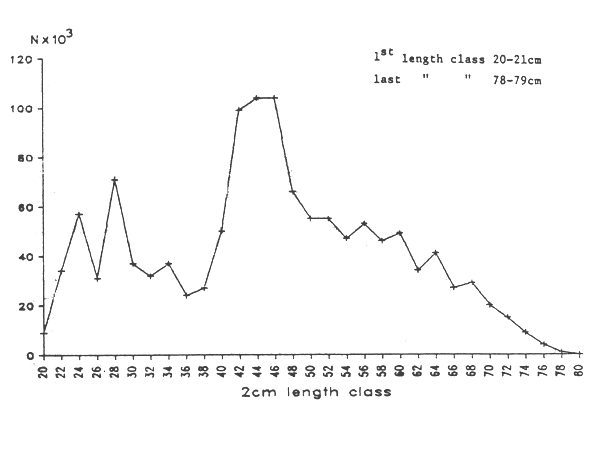
Fig. 1 - Length composition of the 1988 landgins of Merluccius spp Thousands of fish landed
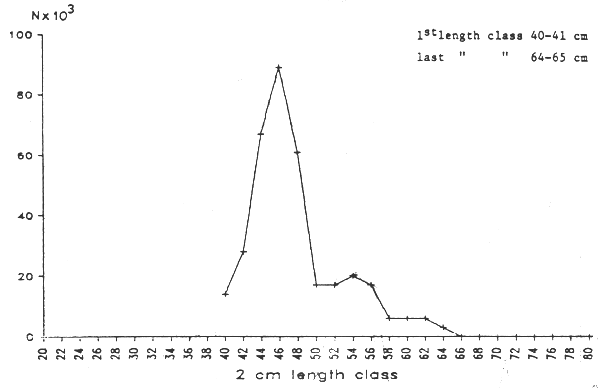
Fig. 2A - Length composition of the 1988 landgins of Black Hake from gill net fishery (Thousands of fish)
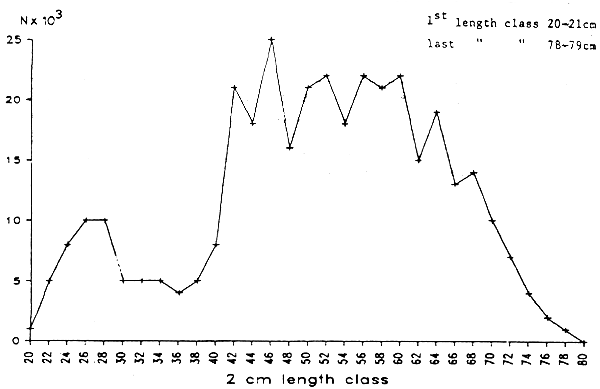
Fig. 2B - Length composition of the 1988 landgins of European Hake from gill net and trawl fisheries (Thousands of fish)

Fig. 2C - Length composition of the 1988 landgins of Merluccius spp. from gill net and trawl fisheries (Thousands of fish)
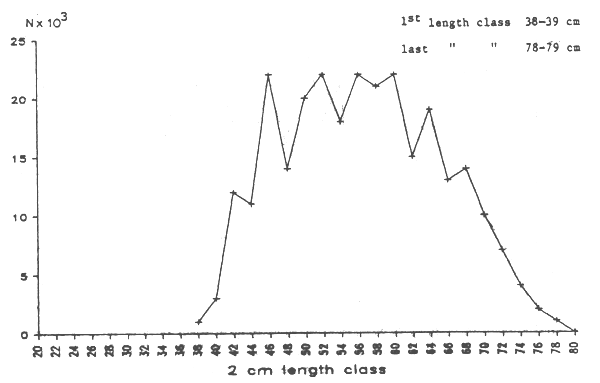
Fig. 3A - Length composition of the 1988 landgins of Merluccius merluccius from gill net fishery (Thousands of fish)

Fig. 3B - Length composition of the 1988 landgins of Merluccius merluccius from trawl fishery (Thousands of fish)

Fig. 3C - Length composition of the 1988 landgins of Merluccius merluccius from gill net and trawl fisheries (Thousands of fish)
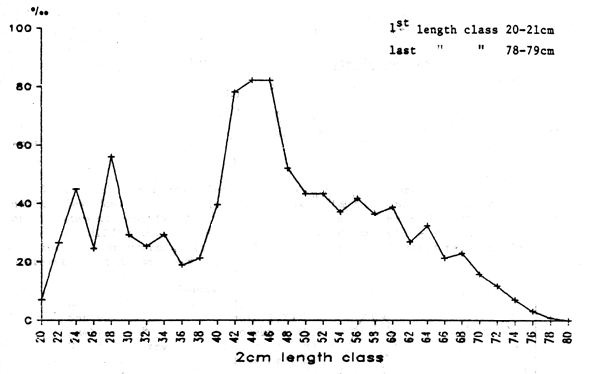
Fig. 4 - Portugues Hake fishery (Merluccius spp. ) 1988 of fish landed
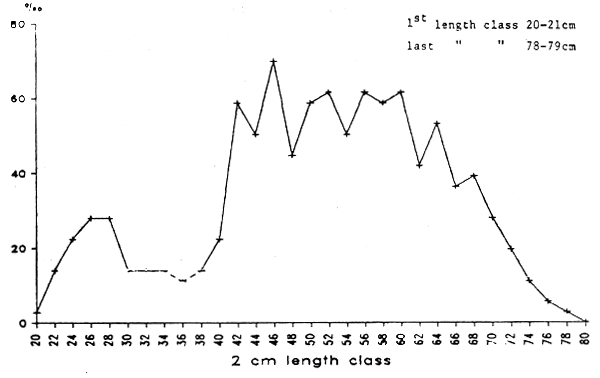
Fig. 5 - Merluccius merluccius - Length composition of landings from the trawl and gill net fishery (1988) ( % of fish )
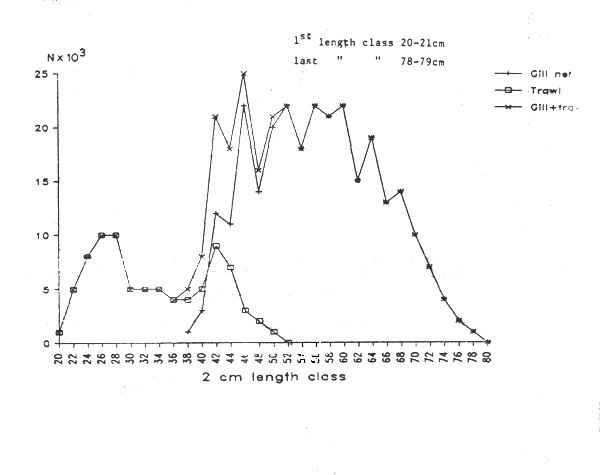
Fig. 6 - Merluccius merluccius - Length composition of landings from the trawl and gill net fishery (1988) (Thousands of fish)